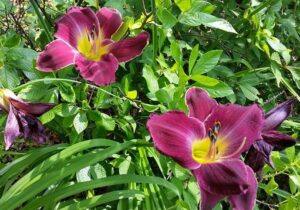This time of year in the Northeast, you drive through the countryside and suburbs where banners of bright orange tiger lilies wave at you as you pass. The tiger lily is a hemoracallis or daylily, meaning that each individual bloom only lasts for 24 hours. Yes, only 24 hours. The reason it seems like the blooms last weeks is because there are so many buds, especially this year.
But there are also hundreds of cultivated species of daylily  in a variety of size, color and even petal shape that populate garden beds around the country. The differences between these cultivars are sometimes startlingly different, and at other times, so subtle as to be noticed only by a trained or appreciative eye.
in a variety of size, color and even petal shape that populate garden beds around the country. The differences between these cultivars are sometimes startlingly different, and at other times, so subtle as to be noticed only by a trained or appreciative eye.
Years ago, when my dad and stepmom moved from the cooler climes of northwestern Pennsylvania to the hotter weather of southern Arizona, my dad gave me divisions of about 50 different daylilies from his gardens. Now, these cultivars battle for garden space with the tiger lilies that were here when Bob and I moved into our home more than 30 years ago.
Although the tiger lilies are generally taller and more aggressive than the cultivated daylilies, the variety of color and shape of the cultivars are what draw my eye. So, every morning or evening, as I walk admiringly past one dramatic bloom or one very soft and subtle, I often think of how we as writers and creatives struggle to capture the attention of clients, readers, agents, and publishers. The advice we often hear at workshops and conferences or in books and on teleseminars is to find a niche. Discover a unique voice or vision, they say. But how? How do you stand out in a field of aggressively thriving tiger lilies without being more aggressive? Without shouting?
It is not by trying to be a tiger lily.
For even though my eye may light first on the taller tiger lilies, it is drawn to and lingers on the variety and unique qualities of the other daylilies. I take great delight in discovering each daylily’s unique qualities and gifts—a ruffled petal here, an intense chartreuse throat there. I can enjoy a delightful perambulation from daylily to daylily around my yard and never see the same bloom twice.
The dramatic golden yellow and purple daylily  shows that for some, that unique voice will be dramatic in its difference, while the delicate peachy pink daylily says that other writers and creators will be more quietly subtle in their personal variations. And, thankfully, for each variation or difference in expression, there will be a collector, a reader, or a client that will value and desire that unique bloom.
shows that for some, that unique voice will be dramatic in its difference, while the delicate peachy pink daylily says that other writers and creators will be more quietly subtle in their personal variations. And, thankfully, for each variation or difference in expression, there will be a collector, a reader, or a client that will value and desire that unique bloom.
You, as a writer or other creator, are unique by virtue of your genetic makeup and your histories (just like the lilies), and by the way you see and respond to the world. You don’t need to struggle to be different. You are different.  Which means your work, if it comes truly from you, from how you see, understand and respond to the world, will be different too.
Which means your work, if it comes truly from you, from how you see, understand and respond to the world, will be different too.
Maybe the question to ask isn’t, “How am I different?” Maybe the real question is, “How am I most myself?”
So don’t fight with the tiger lilies. Just be your unique self—and bloom!
Save